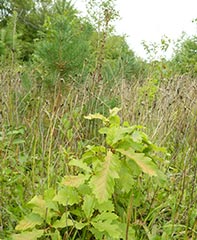Deer tolerant regeneration of forest by direct seeding

Background
Planting is commonly used to regenerate broadleaves and several conifers following clear-felling or windfall in spruce plantations. Many of the desired species for these sites need protection against the browsing and fraying deer.
Deer fences are expensive to establish, maintain and remove again as well as they exclude the deer from some of the best habitats in the forests. Additionally, this may very well lead to a significantly increased damage on the remaining parts of the forest as well as on farmland and elsewhere in the landscape. Deer fences may therefore lead into an unfortunate and self-reinforcing development including an increased need for fences.
The dense roe deer population on the island makes it impossible to establish broadleaves by planting without protection by fence. Additionally, a fallow deer population has established on the island, too.
 Direct seeding has elsewhere been used in some cases to establish very dense forest regenerations that have established well without fencing and have been robust against deer damage. Often natural regeneration of other species such as birch or sycamore maple has contributed. Such unfenced sites with dense forest regeneration serve both their prime objective as well as they are attractive habitats for the deer since they provide good access to both food and shelter for the animals. Additionally, they are cheaper to establish than the common plantings – both because direct seeding is cheaper and because fencing is less needed.
Direct seeding has elsewhere been used in some cases to establish very dense forest regenerations that have established well without fencing and have been robust against deer damage. Often natural regeneration of other species such as birch or sycamore maple has contributed. Such unfenced sites with dense forest regeneration serve both their prime objective as well as they are attractive habitats for the deer since they provide good access to both food and shelter for the animals. Additionally, they are cheaper to establish than the common plantings – both because direct seeding is cheaper and because fencing is less needed.
Objectives
The objective of this research and development project is to test, adapt and demonstrate the deer tolerant regeneration methods at a larger clear-cut area (6 hectares) following Norway spruce under the site conditions commonly found at the island. The mature spruce plantation becomes more and more unstable and susceptible to thinning as they grow older which is why they need to be clear-cut when regenerated.
A successful establishment by direct seeding of several desired broadleaves and conifers without protective deer fences will pave the road for better integration of objectives in forest management regarding
- nature conservation and biodiversity by supporting regeneration of a larger number of tree and shrub species
- deer and hunting by avoiding or minimizing the use of fences and by the attractive densely stocked forest regeneration including many tree and shrub species which are attractive for the deer
- long term forest stability, adaptability and productivity.
Further, the regeneration methods based on direct seeding offers lower regeneration costs which is an important feature in efficiently supporting the establishment of a wider range of forest tree species.
Financial support
The project tittle is “Bornholm exhibition of sustainable and integrated game, forest and nature management in ecological and economical balance” and it is supported by 15. Juni Fonden
